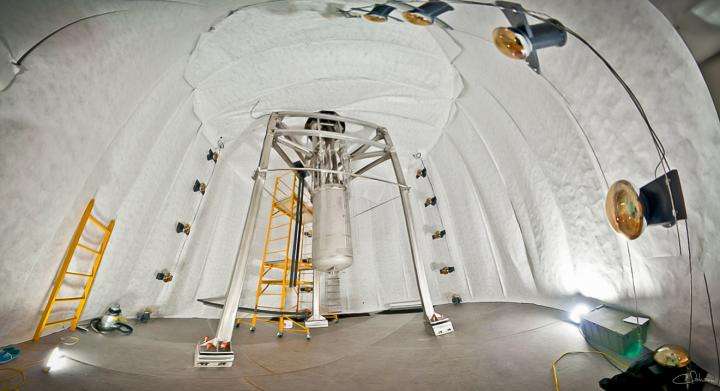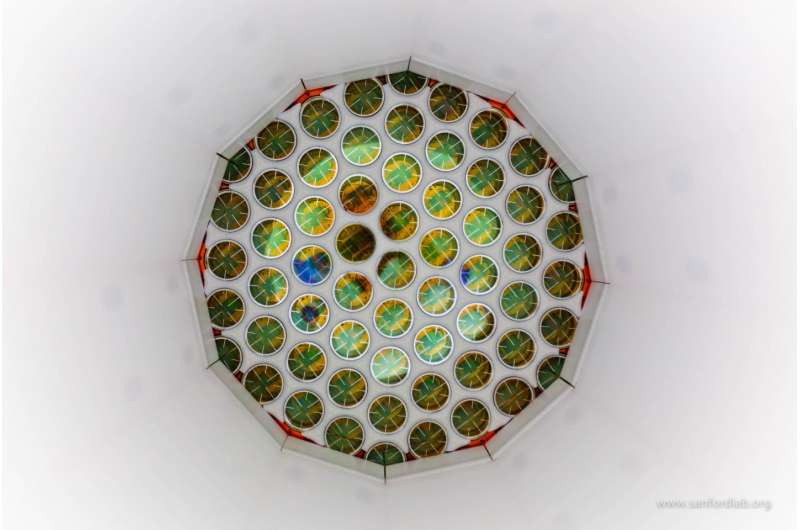World's most sensitive dark matter detector completes search

The Large Underground Xenon (LUX) dark matter experiment, which operates beneath a mile of rock at the Sanford Underground Research Facility in the Black Hills of South Dakota, has completed its silent search for the missing matter of the universe.
Today at an international dark matter conference (IDM 2016) in Sheffield, U.K., LUX scientific collaborators presented the results from the detector's final 20-month run from October 2014 to May 2016. The new research result is also described with further details on the LUX Collaboration's website.
LUX's sensitivity far exceeded the goals for the project, collaboration scientists said, but yielded no trace of a dark matter particle. LUX's extreme sensitivity makes the team confident that if dark matter particles had interacted with the LUX's xenon target, the detector would almost certainly have seen it. That enables scientists to confidently eliminate many potential models for dark matter particles, offering critical guidance for the next generation of dark matter experiments.
"LUX has delivered the world's best search sensitivity since its first run in 2013," said Rick Gaitskell, professor of physics at Brown University and co-spokesperson for the LUX experiment. "With this final result from the 2014 to 2016 search, the scientists of the LUX Collaboration have pushed the sensitivity of the instrument to a final performance level that is four times better than the original project goals. It would have been marvelous if the improved sensitivity had also delivered a clear dark matter signal. However, what we have observed is consistent with background alone."
Dark matter is thought to account for more than four-fifths of the mass in the universe. Scientists are confident of its existence because the effects of its gravity can be seen in the rotation of galaxies and in the way light bends as it travels through the universe, but experiments have yet to make direct contact with a dark matter particle. The LUX experiment was designed to look for weakly interacting massive particles, or WIMPs, the leading theoretical candidate for a dark matter particle. If the WIMP idea is correct, billions of these particles pass through your hand every second, and also through the Earth and everything on it. But because WIMPs interact so weakly with ordinary matter, this ghostly traverse goes entirely unnoticed.
The LUX detector consists of a third-of-a-ton of cooled liquid xenon surrounded by powerful sensors designed to detect the tiny flash of light and electrical charge emitted if a WIMP collides with a xenon atom within the tank. The detector's location at Sanford Lab beneath a mile of rock, and inside a 72,000-gallon, high-purity water tank, helps shield it from cosmic rays and other radiation that would interfere with a dark matter signal.
The 20-month run of LUX represents one of the largest exposures ever collected by a dark matter experiment, the researchers said. The rapid analysis of nearly a half-million gigabytes of data produced over 20 months was made possible by the use of more than 1,000 computer nodes at Brown University's Center for Computation and Visualization and the advanced computer simulations at Lawrence Berkeley National Laboratory's National Energy Research Scientific Computing Center.
Careful calibration
The exquisite sensitivity achieved by the LUX experiment came thanks to a series of pioneering calibration measures aimed at helping scientists tell the difference between a dark matter signal and events created by residual background radiation that even the elaborate construction of the experiment cannot completely block out.
"As the charge and light signal response of the LUX experiment varied slightly over the dark matter search period, our calibrations allowed us to consistently reject radioactive backgrounds, maintain a well-defined dark matter signature for which to search and compensate for a small static charge buildup on the Teflon inner detector walls," said Dan McKinsey, professor of physics at the University of California, Berkeley, senior faculty scientist at Lawrence Berkeley National Laboratory, and co-spokesperson for the LUX experiment.
One calibration technique used neutrons as stand-ins for WIMPs. By firing a beam of neutrons into the detector, scientists were able to carefully quantify how the LUX detector responds to the signal expected to be produced from a WIMP collision. Other calibration techniques involved injecting radioactive gases into the detector to help distinguish between signals produced by ambient radioactivity and a potential dark matter signal.
These calibration measures, used for the first time with LUX, helped scientists meticulously search through a wide swath of potential parameter space for dark matter particles.

"These careful background-reduction techniques and precision calibrations and modeling have enabled us to probe dark matter candidates that would produce signals of only a few events per century in a kilogram of xenon," said Aaron Manalaysay, the analysis working group coordinator of the LUX experiment and a research scientist from the University of California, Davis, who presented the new results in Sheffield.
"We worked hard and stayed diligent over more than a year and a half to keep the detector running in optimal conditions and maximize useful data time," said Simon Fiorucci, physicist at Lawrence Berkeley National Laboratory and science coordination manager for the experiment. "The result is unambiguous data we can be proud of and a timely result in this very competitive field—even if it is not the positive detection we were all hoping for."
The quest continues
While the LUX experiment successfully eliminated a large swath of mass ranges and interaction-coupling strengths where WIMPs might exist, the WIMP model itself, "remains alive and viable," said Gaitskell, the Brown University physicist. And the meticulous work of LUX scientists will aid future direct detection experiments.
"We viewed this as a David and Goliath race between ourselves and the much larger Large Hadron Collider (LHC) at CERN in Geneva," Gaitskell said. "LUX was racing over the last three years to get first evidence for a dark matter signal. We will now have to wait and see if the new run this year at the LHC will show evidence of dark matter particles, or if the discovery occurs in the next generation of larger direct detectors."
Among those next generation experiments will be the LUX-ZEPLIN (LZ) experiment, which will replace LUX at the Sanford Underground Research Facility.
Compared to LUX's one-third-ton of liquid xenon, LZ will have a 10-ton liquid xenon target, which will fit inside the same 72,000-gallon tank of pure water used by LUX to help fend off external radiation.
"The innovations of the LUX experiment form the foundation for the LZ experiment," said Harry Nelson, University of California, Santa Barbara, and spokesperson for LZ. "We expect LZ to achieve 70 times the sensitivity of LUX. The LZ program continues to pass its milestones, aided by the terrific support of the Sanford Lab, the Department of Energy and its many collaborating institutions and scientists. LZ should be online in 2020."
LUX, the first major astrophysics experiment in the Davis Campus of the Sanford Underground Research Facility (Sanford Lab), was installed in 2012. Sanford Lab is located in the former Homestake Gold Mine in Lead, S.D. A South Dakota-owned facility, it is managed by the South Dakota Science and Technology Authority (SDSTA), which reopened the mine in 2007 with $40 million in funding from the South Dakota State Legislature and a $70 million donation from philanthropist T. Denny Sanford. The U.S. Department of Energy (DOE) supports Sanford Lab's operations.
"The global search for dark matter aims to answer fundamental questions about the makeup of our universe. We're proud to support the LUX collaboration and congratulate them on reaching this higher level of sensitivity," said Mike Headley, executive director of the SDSTA. "We're looking forward to hosting the LUX-ZEPLIN (LZ) experiment, which will provide another major step forward in sensitivity."
The LUX scientific collaboration, which is supported by the DOE and National Science Foundation, includes 20 research universities and national laboratories in the United States, the United Kingdom and Portugal.
Over the next few months, LUX scientists will continue to analyze the crucial data that LUX was able to provide, in hopes of helping future experiments finally pin down a dark matter particle.
"LUX has done much more in terms of its sensitivity and reliability than we ever expected it to do," Gaitskell said. "We always want more time with our detectors, but it's time to take the lessons learned from LUX and apply them to the future search for dark matter."
Provided by Brown University




















